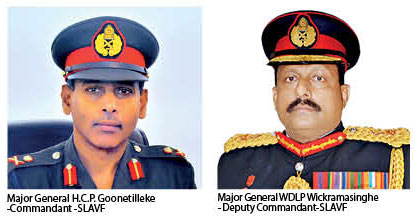Reply To:
Name - Reply Comment
 The Sri Lanka Army Volunteer Force (SLAVF), a reserve force component of the Sri Lanka Army is celebrating its 135th anniversary this year.
The Sri Lanka Army Volunteer Force (SLAVF), a reserve force component of the Sri Lanka Army is celebrating its 135th anniversary this year.
The SLAVF is a collective name for the reserve units and the Sri Lanka National Guard of the Sri Lankan Army. It is made up of part-time officers and soldiers paid at a similar rate, while engaged on military activities, as their regular equivalents.
The SLAVF with its inexplicable contribution to the development of the nation, ever since its early beginnings as a small force has grown to 101 battalions consisting of 2,838 officers and 68,449 other ranks deployed across the country.
In 1910 the name of the military was formerly changed to the Ceylon Defence Force (CDF). During the First World War, many volunteers from the Defence Force travelled to England and joined the British Army. In 1939 with the Second World War CDF was mobilised and expanded to fortify Ceylon to meet a possible threat posed by the Japanese.
The CDF was officially disbanded in 1949 and reconstituted by Army Act No. 17 of 1949 which revoked the Ceylon Defence Force Ordinance of 1910 as the Ceylon Volunteer Force (CVF), itself becoming the Sri Lanka Army Volunteer Force (SLAVF) in 1972.
Following the formation of the army in 1949, the CDF became the nucleus of the Ceylon Army and all volunteer units of the CDF—which was the majority of the CDF— became the Ceylon Volunteer Force (CVF).
Since 1983 till 18 May 2009, 104 Officers and 3550 Other Ranks have paid the supreme sacrifice whilst 146 Officers and 3568 Other Ranks have been wounded. In this 08 Officers and 252 Other Ranks are missing in action.Since 2004 up to date 76 Officers and 1518 Other Ranks of Volunteer Force have participated for United Nation Peacekeeping Missions in Haiti. Increasing the number of SLAVF members AT UN Peacekeeping force in another objective of the SLAVF.
Commandant and Deputy Commandant of the SLAVF
The commandant of the SLAVF is chosen from the SL Army Regular Force and the volunteers could only go higher to the rank of Major General as at present.
Major General H.C.P. Goonetilleke was appointed Commandant of the SLAVF in 2015. He enlisted in the Sri Lanka Army on 1981 having completed his primary and secondary education at St Benedict’s College and Royal College. He was commissioned in the Corps of Engineers as a Second Lieutenant in 1982.

Major General WDLP Wickramasinghe, the Deputy Commandant of the SLAVF have assumed Office in 2012. He joined the SLAVF as a Cadet Officer in 1979 and was commissioned as Second Lieutenant into 2 Battalion of Sri Lanka Army Service Corps (Volunteer) in 1980.
Major General Goonetilleke said being a head of a volunteering force is much more significant than in a Regular Force. It gives you more exposure. D. S. Senanayake, first Prime Minister of Ceylon and General Sir John Kotelawala, third Prime Minister was products of the volunteering force and served immensely to the motherland.
“The fighting spirit and the adaptability are two key components of the success of the SLAVF that represents 70,000 out of the 180,000 SL Army and from that 70,000 about 15% are engaged in various other jobs. There is no major difference between the Regular Force and the Volunteer Force. They both have given their lives and commitment to the country special during the war. The difference between the Regular force and Volunteer force is that SLAV members could shift to another job while been at the volunteer force.
Throughout our 135 history, the SLAVF had contributed in safeguarding the country and in the future, the mission of SLVAF will be to contribute to the development of the country to improve the economy.The SL Army is transforming into a Knowledge Based Technology Driven Force, therefore, the SLAVF would also have to adjust. To do that the SLAVF had opened its doors to professionals,” he said.
A tree planting campaign by 100 battalions of the Volunteer Force with each battalion planting and nurturing 135 area specific plants, maintaining 100 Battalions Headquarters as dengue free zones and combating non communicable disease among the rank and file would be organised at the commemoration.